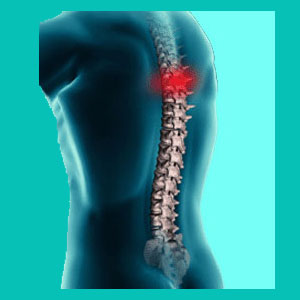
The thoracic herniated disc diagnosis is one of the least common of all disc abnormalities that are implicated for sourcing upper back pain. In most cases, thoracic herniations are not blamed as the source of chronic upper or middle back pain, since the discs in the thoracic levels are not prone to the same degree of degeneration, nor the same disposition to injury, as the spinal spacers in the neck and lower back regions.
However, this is not to say that thoracic herniations can not exist, for they surely can and do. Worse still, many are not correctly diagnosed as the true source of pain, while other coincidental disc abnormalities might instead take the blame.
This essay examines the diagnostic process for damaged and desiccated thoracic spinal discs, as well detailing what to expect if you have been diagnosed with a herniated disc in the upper or middle back.
Thoracic Herniated Disc Diagnosis Process
Just like other type of herniated disc, intervertebral bulges and ruptures in the middle and upper back can be positively identified using MRI and CT scan technologies, among others. X-rays will not be able to verify a herniated disc and any type of physical exam is certainly not sufficient to make the diagnosis.
Thoracic discs are not nearly as likely to become herniated as those in other spinal zones, especially from normal spinal degeneration. However, they can become damaged by traumatic injury or idiopathic conditions. Fortunately, most minor to moderate disc issues in the upper and middle back areas are not symptomatic or pathological in any way. Since the thoracic spine is not called upon to perform in the same manner as the neck or the lumbar regions, even significant disc pathologies are often only mildly symptomatic, if at all.
Thoracic Disc Pain Misdiagnosis
Disc issues which are blamed for enacting pain, and related neurological complaints in the middle back, are rare. This is good, since statistics clearly show that most herniations are not any reason for fear and that those in the thoracic spine are especially innocent and coincidental to most painful conditions.
In the event that a patient does have a serious structural disc issue in the middle back, it may take some time to develop a treatment plan, since the vast majority of herniated disc care is focused on cervical herniations and lumbar herniated discs.
Going to consult with a specialist may be a good idea in these cases, although never discount the possibility of misdiagnosis when it comes to thoracic disc-related back pain. After all, many patients are diagnosed and seek treatment, but never find relief. The primary reason why this occurs is due to a misidentification of a coincidental thoracic disc irregularity as the cause of pain. This is especially prevalent when other possible disc concerns in the neck are absent.
Thoracic Herniated Disc Diagnosis Editorial
In our experience, the most commonly implicated mid-back disc conditions are related to 3 distinct circumstances:
The first category includes patients who suffer from atypical spinal curvature, such as scoliosis or kyphosis, and might have extenuating circumstances as to why they are suffering abnormal thoracic spinal degeneration. Discs may bulge violently when the spine curves significantly and abnormally side-to-side or front-to-back. Discs might also bulge when a sizeable loss of front-to-back-curvature is enacted.
The other category of thoracic disc pain sufferers includes post-spinal fusion patients whose spinal degeneration was caused by the procedure and are now suffering from a domino effect of problems which will likely plague them for life.
In virtually all other instances of thoracic disc pain, representing the third category, there is almost always some form of extreme spinal trauma involved to cause the injury. Motor vehicle accidents, serious falls and other damaging acts can all affect the upper and middle back regions, facilitating possibly pathological disc conditions that might or might not be discovered during the typical diagnostic process.
Herniated Disc > Herniated Disc in the Upper Back > Thoracic Herniated Disc Diagnosis




